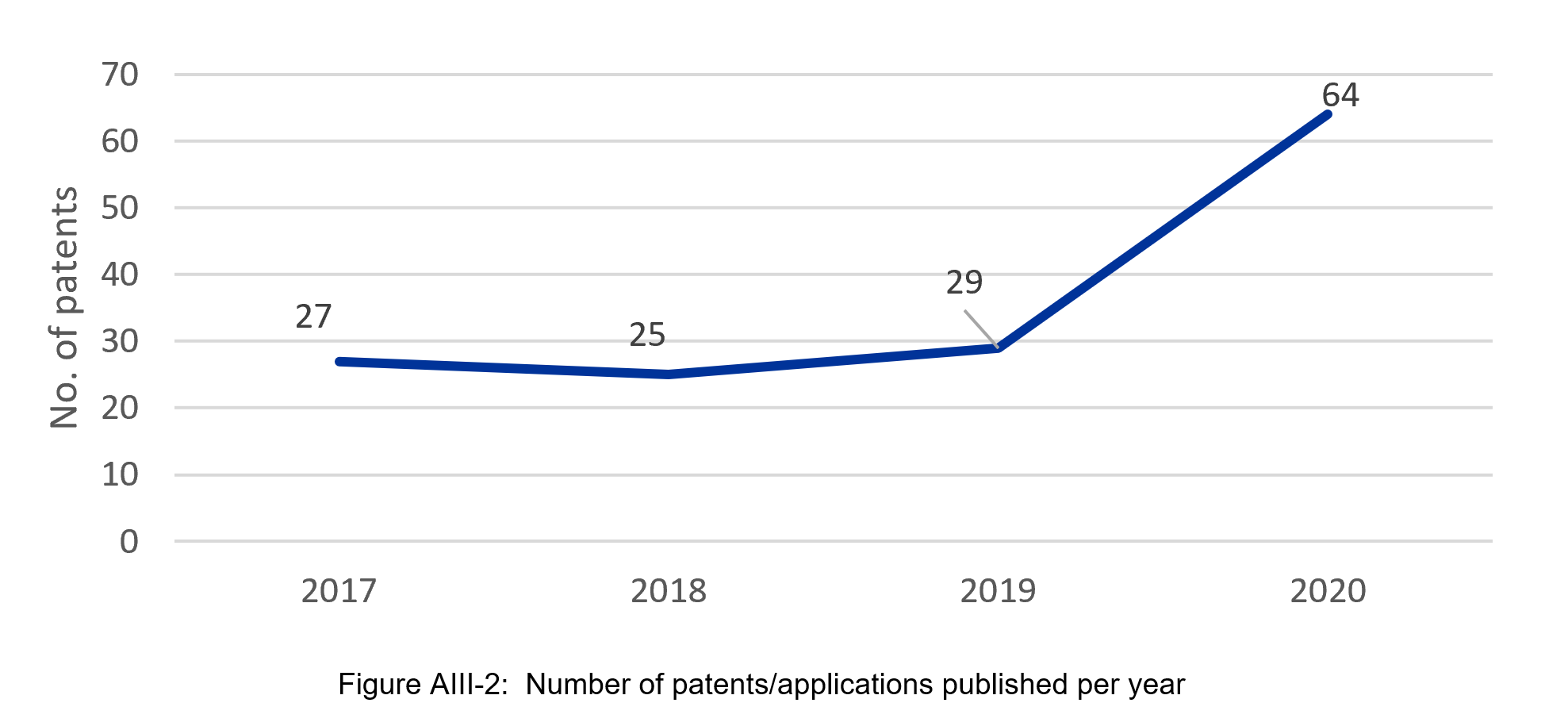Patents - EUON
Cosmetics
This section looks at the patenting activity in the field of nanotechnology and textiles between 2017-2020. Granted patents and patent applications focused on textiles and nanotechnology were extracted from the general collection of nanotechnology patents between 2017-2020 developed by the study team for the database. The patents were collected from Espacenet database maintained by the European Patent Office.
The dataset of patents on cosmetics and nanotechnology was developed by extracting the granted patents and patent applications that contained the CPC classes and sub-classes dedicated to cosmetics in their bibliographic information. It should be noted that most nanotechnology patents contain multiple classes in their subject descriptions. Cosmetic products are listed under A61K8/00 and A61Q CPC classes.
| Table AIII-5: Cosmetics in the Cooperative Patent Classification (CPC)1 | |
|---|---|
| Class | Title |
| A61K8/00 | Cosmetics or similar toilet preparations |
| A61Q | Specific use of cosmetics or similar toilet preparations |
Patents on nanotechnology in Cosmetics
As a result of patent collection mining, 145 patent applications and granted patents published from 2017-2020 were identified. The number of patents and patent applications containing cosmetics classifications was steadily low between 2017-2019 with an increase of interest in 2020.

Most patents/applications (93, 64%) were published in the national patent offices, while the rest were in the World Intellectual Property Organisation (WIPO, 48, 33%) and the European Patent Office (4, 3%).
China (50 applications, 35%) prevailed among the countries where most patent applications were published. Other countries, such as the USA (13, 10%), Japan (12, 8%) and South Korea (9, 6%) published fewer patents/applications.
Patent applications and granted patents contained two CPC sub-classes referring to cosmetics. All patents/applications (143, 99%) focused on specific uses of cosmetics and toilet preparations (A61Q) except two – on cosmetic and toilet preparation products.
| Table AIII-6: Examples of patent applications focused on A61Q sub-class | |
|---|---|
| Bibliographic information | Abstract |
| Iwakuni, M. et al. (2018). Titanium phosphate powder, production method therefor, and white pigment for cosmetics. No. WO2018180797A1. Available here. | The titanium phosphate powder according to the present invention comprises plate-shaped crystalline particles of titanium phosphate, wherein the plate-shaped crystalline particles have an average thickness of not less than 0.01 μm but less than 0.10 μm, and an aspect ratio obtained by dividing the average primary particle size of the plate-shaped crystalline particles by the average thickness is not less than 5. In the production method for titanium phosphate powder according to the present invention, when titanium phosphate powder comprising plate-shaped crystalline particles of titanium phosphate is produced by reaction of a raw material containing titanium and phosphorus by a hydrothermal synthesis method, a mixture of titanium sulphate and phosphoric acid is used as the raw material. |
| Uyama, M. et al. (2019). Oil-in-water microemulsion cosmetic composition. No. WO2019187703A1. Available here. | The present invention provides a novel stable oil-in-water microemulsion cosmetic composition. An oil-in-water microemulsion cosmetic composition according to the present invention contains: a dispersion medium which contains water and a divalent glycol; an oil component which is dispersed in the dispersion medium, while containing a silicone oil and a hydrocarbon oil; a carboxyl-modified silicone surfactant represented by formula 1; at least one compound which is in a liquid state at 25°C and has 16-22 carbon atoms, and which is selected from among higher alcohols and higher fatty acids; and a non-ionic surfactant which has a polyoxyethylene chain, while having an HLB of 12-17. This oil-in-water microemulsion cosmetic composition is configured such that the average particle diameter of oil droplets is 150 nm or less. In formula 1, at least one of R1-R3 moieties is expressed by -O-Si(R4)3 wherein R4 represents at least one substituent selected from among alkyl groups having 1-6 carbon atoms and a phenyl group; in cases where not all of the R1-R3 moieties are the substituents, the rest may be the same or different and each represents a substituted or unsubstituted monovalent hydrocarbon group; A represents a linear or branched alkylene group which is represented by CqH2q wherein q represents an integer of 0-20; and M represents a metal atom or an organic cation. |
Cosmetics innovation breakthroughs in patents
Innovation breakthrough is a particular type of innovation that has a profound effect on subsequent inventions, products and services. Three indicators of patents were studied to identify innovation breakthroughs – number of forward citations, number of citing organisations and number of citing countries. The study did not identify innovation breakthroughs in cosmetics patents between 2017-2020.
1 European Patent Office. (2022). Cooperative Patent Classification, A: Human necessities agriculture. Available at: https://www.cooperativepatentclassification.org/sites/default/files/cpc/scheme/A/scheme-A.pdf


